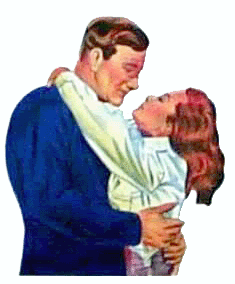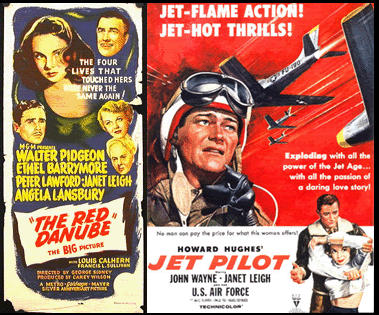I just hope everyone remembers to TRIM BACK! the vegetation so half of the sidewalks aren’t stolen from pedestrians; in the ‘burbs, this is a non-issue, but in downtown T.O., every inch of sidewalk is important.

In any event, the first set of films reviews are up, and the theme today is the Cold War film, which isn’t really a full-fledged genre because it’s comprised of several strands. You’ve probably heard of a few: the Red Menace film. The Cold War drama. The Cold War thriller. The Propaganda film.
It’s easy to apply genre nomenclature with ease, but one has to think about a film’s tone and whatever subtext is at work before slapping it as anti-Commie, Cold War propaganda (or one of each).
Not long ago I reviewed Berlin Express (1946), which loosely dealt with western suspicions of Soviet reserve and chilly demeanor under the guise of an anti-Nazi thriller set in postwar Berlin. The film was more pro-Soviet bridge-building propaganda than Cold War thriller, if not a message picture telling everyone to swallow political differences and work towards rebuilding a Germany that can symbolize a restored functional democracy for future conflicts.
My Son John (1952), Leo McCarey’s drama about a mother who suspects her son is a Commie spy is part of the Red Menace genre that was overtly anti-Soviet. In a Red Menace film, Communism is a disease that infected war-ravaged nations from the democratic west, and now its spies are infiltrating upper-tier levels of western governments. It’s no wonder that the fear of conquest and loss of humanism and free thinking were absorbed into the sci-fi genre, and Commie agents were reconfigured as bug-eyed alien monsters out to smite the human race (represented by America, Britain, and colonial/Commonwealth peoples.
(Funnily, Canada never really figured in any of these dramas except for one film, Fox’ 1948 production of The Iron Curtain, based on the Igor Gouzenko case where a Soviet file clerk uncovered espionage plans against the west. If the 1948 Gouzenko Affair was pivotal to igniting a broad fear of Soviet spying, then 1948 can also been seen as a watershed when Hollywood started to exploit distrust, loathing, and vilification of anything Soviet during the late forties thru the early sixties.)
So what exactly are the nuances that differentiate the sub-genres from each other? And why are these differences important?
The examples I’m picking are two films that had a young Janet Leigh, and illustrate the tonal shift between the lets-work-together message of Berlin Express, and the vilification of Communism in My Son John.
Red Danube (1949) marks the stage where American filmmakers started to reconfigure Soviets as villains, but only after evidence made its way to the United Nations via persecuted German-Russians being sent back from Vienna to the USSR for repatriation, and life in a gulag.
At the center of this social and humanitarian dilemma is a dancer named Olga (Leigh), whop falls in love with a British officer. The Soviets are no longer comprised of a few staunch soldiers with the potential for humanism, as dramatized in the finale of Berlin Express. In 1949, Soviets were a cold, scheming mass exploiting the fair play rules of Allied power-sharing agreements, packing refugees into cramped cattle trains that, in the film, evoke the Nazis’ deportation of Jews to the death camps – unsubtle visuals director George Sidney played out with stark photography.
In Red Danube, Leigh was a starlet, and as the film review details, she wasn’t exactly the best choice, and Sidney (and MGM) seemed to recognize her weaknesses called for some careful film editing and direction.
A year later, Leigh landed the role of another Olga in Jet Pilot (1950/1957), Howard Hughes’ weird kludge of air force actioner, romance, and comedy with a comic book anti-Commie tone. Those familiar with Hughes’ tenure at studio RKO know Jet Pilot was a problem-plagued production that took several years to complete, and wasn’t released until 1957 when RKO was dead.
John Wayne is assigned to learn Olga’s flying tricks and verify if her desire to defect is earnest, but love and some duplicitous behaviour has the couple making a run for Soviet Russia in the film’s final third. If one ignores the odd comedic moments, the bizarre romance-by-jet plane, and director Joseph von Sternberg’s gorgeous Technicolor compositions, Jet Pilot’s message is like a ‘last call’ for latent/secret capitalist Russians to join the free world before the Cold War settles in.

The spying elements are feeble, and Olga is never in any real position to endanger the U.S. Air Force because Wayne’s superiors have kept her carefully monitored, with Wayne always close by. There’s no upset of the general social order because she’s not allowed to mingle (and actually doesn’t care to mingle) with average Americans in Palm Springs. Arabian jammies excepted (see picture above), Olga just wants to pick Wayne’s brain for military secrets, and head back home. Moreover, everyone knows she’s a Communist, so there’s no secrecy besides whether she really loves Wayne for real.

Both films were prestige production to the extent of being major studio releases headed by major stars. MGM undoubtedly treated Red Danube like a high, hot-button drama, whereas Hughes sold Jet Pilot as a high-octane tale of two flyers finding love in the air; the key art for Danube showcased conflicted heads surrounding a potential hussy (Leigh), whereas the recurring motif of the Pilot campaign art has Olga inches away from removing her T-shirt, and presenting a WTF-visaged Wayne her pointy, militaristic pontoons.
At best, Jet Pilot is a Cold War romance-actioner, but the only drama probably lay off-screen, in von Sternberg’s effort to deliver a tonally balanced fine cut to RKO before Hughes ordered reshoots spanning two years.
The irony is that whereas the earnest message of Danube should’ve given it some longevity as a classic, it’s just a clunky dated melodrama torpedoed by some heavy-handed elements, and a terrible central performance. Pilot became a cult film because it was released years after principal photography, and when it emerged in theatres, the actors looked way younger. Then the film disappeared, and became a kitsch favourite during the eighties.
Part of the fun in examining these films is seeing what works, where the filmmaker stumbles, and in the case of Pilot, is the film the godawful disaster that cheeky pundits claimed it to be.
The Red Danube recently aired on TCM, and it’s doubtful it’ll make its way to DVD, except perhaps as a Warner Archive title (which means U.S. only). Jet Pilot has appeared on DVD via Goodtimes Home Video and MCA’s John Wayne: An American Icon Collection set, but only KOCH Germany took the bull by the horns and released the film on DVD in a new 1.78:1 anamorphic transfer. Do check out the reviews for more details.
- MRH







0 comments:
Post a Comment